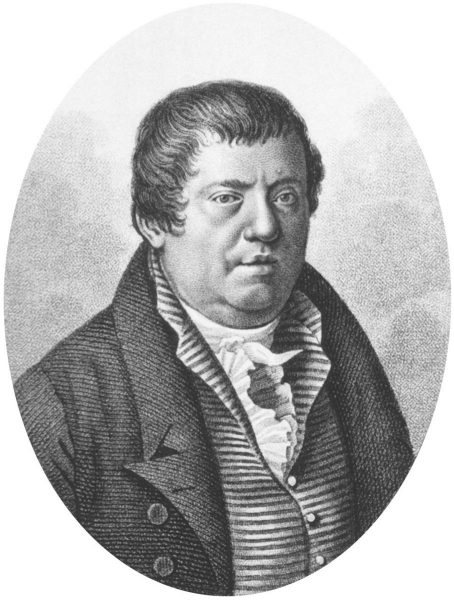
John Leslie (1766 – 1832)
On April 10, 1766, Scottish mathematician and physicist Sir John Leslie was born. Leslie is best remembered for his research into heat. He gave the first modern account of capillary action in 1802 and froze water using an air-pump in 1810, the first artificial production of ice.
“The true business of the philosopher, though not flattering to his vanity, is merely to ascertain, arrange and condense the facts. “
— Sir John Leslie [10]
Early Life and Education
Leslie was born the son of Robert Leslie, a joiner and cabinetmaker, and his wife Anne Carstairs, in Largo in Fife. He received his early education there and at Leven. In his thirteenth year, encouraged by friends who had even then remarked his aptitude for mathematical and physical science, he entered the University of St Andrews. On the completion of his course in 1784, he nominally studied divinity at Edinburgh University but gained no further degrees. During the following years Leslie worked as a private tutor and prepared a translation of Buffon’s Natural History of Birds, published in 1793. John Leslie continued his physical studies, published them in Nicholson’s Philosophical Journal and earned the Rumford Medal of the Royal Society of London for his work on Experimental Inquiry into the Nature and Properties of Heat.
Academic Career
Leslie first worked as a tutor. In 1805, Leslie succeeded John Playfair in the chair of mathematics at Edinburgh.[4] There, he published two volumes of A Course of Mathematics-the first, entitled Elements of Geometry, Geometrical Analysis and Plane Trigonometry, in 1809, and the second, Geometry of Curve Lines, in 1813. The third volume, on Descriptive Geometry and the Theory of Solids was never completed.
Research into Heat
In 1810 he was the first to produce artificial ice with the help of an airpump. He had developed an absorption refrigeration system using water and sulphuric acid as the two materials. In 1813, John Leslie published A Short Account of Experiments and Instruments depending on the relations of Air to Heat and Moisture. This work was based on his invention of a process of artificial ice-making. Also in 1818, Leslie published On certain impressions of cold transmitted from the higher atmosphere, with an instrument (the aethrioscope) adapted to measure them which appeared in the Transactions of the Royal Society of Edinburgh.
Later Years
When John Playfair died in 1819, Leslie was promoted to the more congenial chair of natural philosophy, which he held until his death.Leslie became a member of the Royal Society of Edinburgh and he was promoted to the chair of natural philosophy, which he held until his death. His famous work about multiplication table The Philosophy of Arithmetic was published in 1820. In 1823 he published, chiefly for the use of his class, the first volume of his never-completed Elements of Natural Philosophy.
John Leslie’s Contributions
During his career, John Leslie based many of his contributions to the field of physics on the differential thermometer and Leslie was able to employ it in a great variety of investigations, connected especially with photometry, hygroscopy and the temperature of space. In 1820 he was elected a corresponding member of the Institute of France, the only distinction of the kind which he valued, and early in 1832 he was created a knight.
John Leslie died of typhus in November 1832 at age 66.
Michel van Bizen, Physics 33 – Fluid Statics – Surface Tension (5 of 12): What Causes Capillary Action?, [9]
References and Further Reading:
- [1] Biography of Sir John Leslie
- [2] The Works of Sir John Leslie
- [3] John Leslie Short Biography
- [4] John Leslie, An Experimental Inquiry into the Nature and Propagation of Heat (1804)
- [5] Chisholm, Hugh, ed. (1911). “Leslie, Sir John“. Encyclopædia Britannica (11th ed.). Cambridge University Press.
- [6] William Playfair and the Beginnings of Infographics, SciHi Blog
- [7] Works by John Leslie at Open Library
- [8] Sir John Leslie at Wikidata
- [9] Michel van Bizen, Physics 33 – Fluid Statics – Surface Tension (5 of 12): What Causes Capillary Action?, MIchel van Bizen @ youtube
- [10] John Leslie, ‘Dissertation Fifth: Exhibiting a General View of the Progress of Mathematical and Physical Science, chiefly during the Eighteenth Century’, Encyclopedia Britannica, 7th edn. (1842), 743. In John Heilbron, Weighing Imponderables and Other Quantitative Science around 1800 (1993), 17.
- [11] Timeline of Scottish Scientists, born before 1900, via DBpedia and Wikidata






Pingback: Whewell’s Gazette: Year 3, Vol. #35 | Whewell's Ghost